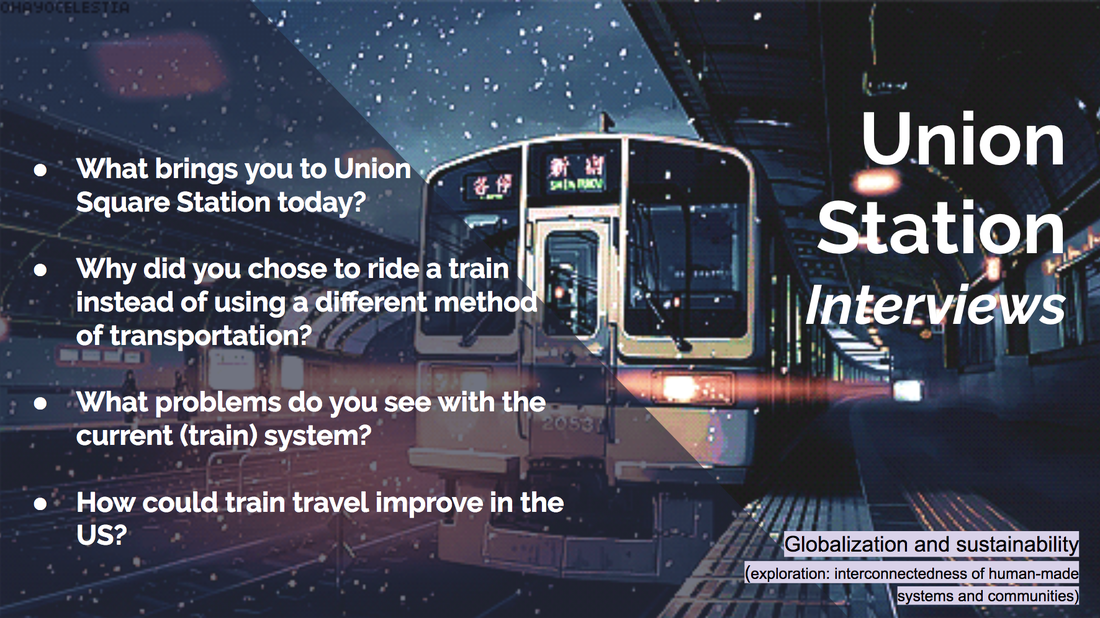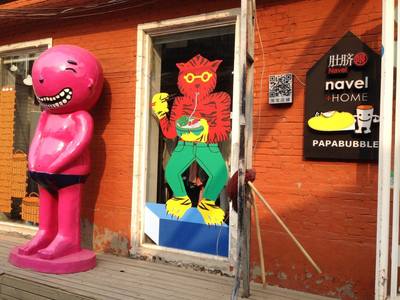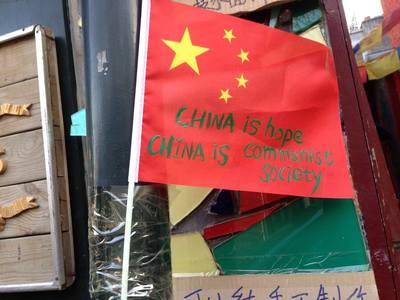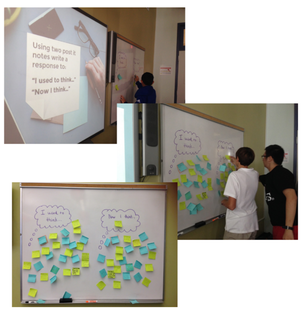|
A while back we had a PD afternoon themed around inclusivity. For me, this was the perfect opportunity to introduce HyperDocs to my colleagues. HyperDocs are interactive worksheets - they are a little different to printable worksheets, because they have links to a digital resources, and students also answer digitally, (which can mean they contribute to collaborative work). I think they are a great way to flip the classroom or for blended learning - students can work at their own pace and the teacher can assist those who need extra help.
My top tips for HyperDocs:
Here are two of my HyperDocs:
Finally saw some resources to get you started with creating your HyperDocs:
We will be visiting Union Square Station to get food while in Washington DC. Students, in groups, including a teacher, will interview people in the station.
IB Global Context: Globalization and sustainability (exploration: interconnectedness of human-made systems and communities) One of the more lighthearted activities we have planned for our Grade 10 trip to Washington is Classical Art Memes! Global Context: Personal and Cultural Expression (exploration: social constructions of reality) We will start off this activity, with the serious prompt "What is Art?"... ...we will then move onto "What is a meme?" We will then show some students come classical art memes we have found online, (best to do this, instead of letting them freely search, because some online are inapropro...) Students will be tasked with creating their own. We may also let them use any photo manipulation tool they want... Here is an example of people using the Face App on works on art:  This activity can easily be adapted for any art gallery...
On last year's trip we seemed to spend a lot of time at the airport waiting at the gate -to make sure we start off the trip well, we decided to add an activity here!
IB Global Context: Scientific and Technical Innovation (exploration: adaptation) The students will get sent a link to the presentation below. It includes information from one of our colleagues, Dennis, a former pilot - as well as the prompt: The plane you are going to fly today may one day also be in a museum. Technology is constantly evolving and adapting and that includes planes! What do you think travel will look like in 30 years time? Students will write their thoughts in their journals.
We think students will get a kick out of seeing these old pictures of Dennis. We will also have them make connections with this presentation when they visit theNational Air and Space Museum in Washington!
What other ways can we kill time while waiting at the gate? I'll bring a few card games, but other ideas would be appreciated :)
Every year our school takes Grade 10 to Washington DC. Last year I became a Grade 10 advisor (to line up with also becoming their Personal Project Coordinator), so had my first ever visit to DC. Two of my colleagues (and friends!), Ilse and Sherry, have been working on changing the experience to make the trip morning meaningful and to link more to the IB - With the help of some thinking routines and the IB's Global Contexts. They brought me on board after their initial planning to help them with the activities.
Throughout the trip, students will be adding notes to a journal. The activities we have designed are supposed to be short and sweet and will not take up the whole time they are at any particular location. I will share several of the activities on this blog, so that other educators may use them in they are also visiting DC. Our activity for the National Museum of African American History and Culture. IB's Global Context: Identities and relationships (exploration: Identity formation; self-esteem; status; roles and role models). This museum opened shortly after our last trip, so none of us have been there yet. However, we were able to use resources we found on their website. When students arrive at the museum, they will sort themselves in small groups, and will each be given a double sided card. On one side they will see the object they should find when walking through the museum - on the other side they will find prompts to answer before and after seeing the object, (we think there might be a bit of a wait outside)!
Here's a link to the presentation - feel free to make a copy and adapt it for your school. You can also find out more about these images on the NMAAHC website here.
More posts about our Washington DC plans soon :)
I was lucky enough to be chosen as a chaperone for a school trip to China. We took 20 Grade 8 and 9 students, who were all learning Chinese, to Beijing, Tianjin and Shanghai.
I took so many photos - here are just a few:
During our first week we stayed at Shanghai High School. The students attended classes throughout the week and we all stayed in dorms. We ate the amazing school food and got to learn lots about the education system in China. During one weekend the students stayed with host families and we were taken on an adventure with some of the Chinese Teachers. This was a really wonderful opportunity, as it gave us an authentic experience.
A short while later many of the students visited us in Atlanta. Chinese students stayed with their host families and we had one of the teachers stay with us. Most of the time students just shadowed their buddies, but we also had a few opportunities to come together as a group - including for a session I ran on stereotypes, assumptions and understanding different cultures. This session included both students from our school and SHHS. Below is the presentation I used for the students and beneath that is a breakdown and reflection of the activities, with a few extra photographs! (You can see in the presentation that in the last slides I added in the students responses)
We started off the session with a Kahoot I created, called 'Where in the world? China or the USA?". Here I purposefully chose some images to confuse students! This was a good opening activity to get the students to be a bit more flexible.
During the next section I used the Chalk Talk thinking routine - where students walk around adding their thoughts to some prompts, and then add further thoughts to their peers' ideas. Many people do this in silence, but I often think the oral discussion which happens when doing this activity is very valuable (and especially important as many of our students, and obviously SHHS' have English as a second language!) Here students had several venn diagrams, with one side being 'America' and the other side being 'China'. They had venn diagrams for; food, city life, education, entertainment and family life. I had all the students work together, but it may have also been interesting to have had the groups work individually or give each school different color pens, as it would help us understand who wrote what (both schools made many of the same assumptions about each other) - however, most of this information came out in the group discussion which followed after.
Much discussion actually happened while students were filling in the venn diagrams - but we also came together as a group after.
The next activity was a I Used to Think, Now I think - here students wrote both responses on a post-it note and added it to the board. I would like to have students brainstorm ideas about the country they are visiting before going and then reflect on those later - however as this was a single lesson, students were allowed to look back to before the trip or the start of the class for their 'I used to think' answer.
To end off the session I gave students the prompt "Why is it important to experience and appreciate another culture?". Students answered this through PollEverywhere, which showed all the responses on the board and also turned them into a live word cloud. I was super impressed with their thoughtful and mature responses, as well as how articulate the students were.
Some of my favorite responses:
I've added the responses from the last two activities into the last slides of the presentation at the top of this post.
Taking part in this Chinese exchange was truly inspiring - This exchange is organized by our Chinese teacher Jie Wu. She has given me so much 'food for thought', as well as so much delicious Chinese food! My teaching is better because of her influence. Hopefully we will collaborate more together in the next school year (watch this space!)
Here are some other unit/lesson ideas I had from our trip:
This was a great opportunity for me, as I tend to only ever visit France (where my mum lives) and England (where the rest of my family live). Although I am slowly exploring more and more of America, I definitely want to see more of the world. On the top of the list of Japan and Mexico. Where else should I visit? What has been your most inspiring vacation? I am writing up my reflections from the Project Zero conference I attended last October - Project Zero Perspectives: Learning Together, Leading Together. See my post on Art and Contemporary Issues here and Stepping into Character here.
From Project Zero: “The Global Lens project is creating a curriculum that aims to educate for global competence. Working in close collaboration with teachers in Boston and Washington, DC, we are exploring how quality interdisciplinary study of global issues and deep engagement with global media can develop young people’s global competence. Come hear about this new project and where our thinking is taking us.” Most of the session was focussed on an activity where we looked at the photograph below...which also happens to be what I took most notes on and will share with you here. Pausing in the rain, a woman working as a trash picker at Nairobi's Dandora dump, which spills into households of one million people living in nearby slums, wishes she had more time to look at the books she sometimes comes across. She even likes the industrial parts catalogs. “It gives me something else to do in the day besides picking [trash],” she said. Image by Micah Albert. Kenya, 2012. When first looking at this photograph I thought it was a painting. Something about the soft tones and the lighting makes it look almost beautiful. It's only when you look deeper and find out more about the context that the ugliness is revealed. We reflected on a picture about the Dandora trash problem in Kenya following different layers of implication to uncover a global perspective of the issue at hand.
Micah Albert has some other photographs which could also be used for this activity: Other useful resources for exploring Dandora/Kenya and/or landfills/dumps:
All schools do units about recycling and waste, but they often don't look at the human stories involved - this activity and a focus on Dandora could be a great way to help students connect to this issue on an emotional level. |
Archives
June 2023
|




































 RSS Feed
RSS Feed